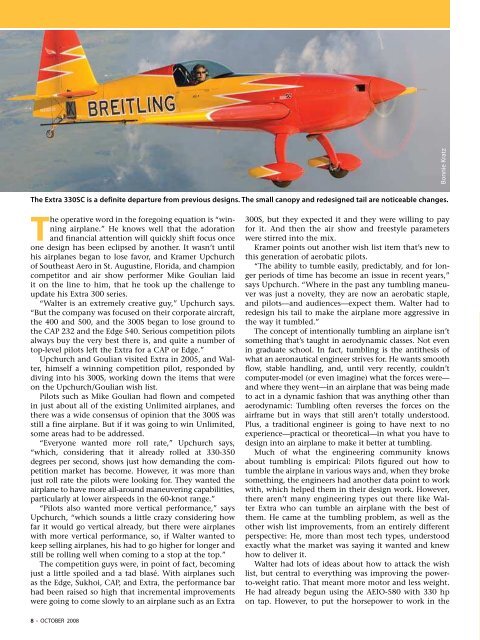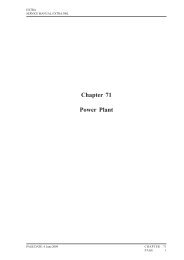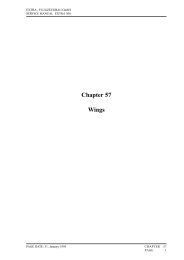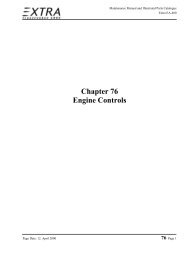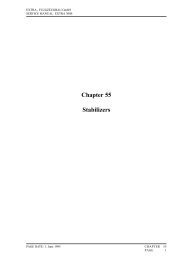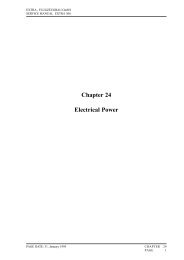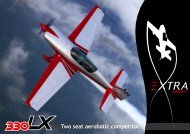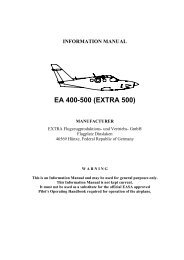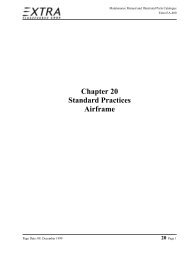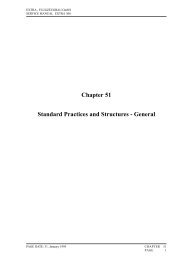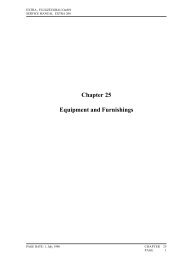2008-10 - Extra Aircraft
2008-10 - Extra Aircraft
2008-10 - Extra Aircraft
You also want an ePaper? Increase the reach of your titles
YUMPU automatically turns print PDFs into web optimized ePapers that Google loves.
The <strong>Extra</strong> 330SC is a definite departure from previous designs. The small canopy and redesigned tail are noticeable changes.<br />
The operative word in the foregoing equation is “winning<br />
airplane.” He knows well that the adoration<br />
and financial attention will quickly shift focus once<br />
one design has been eclipsed by another. It wasn’t until<br />
his airplanes began to lose favor, and Kramer Upchurch<br />
of Southeast Aero in St. Augustine, Florida, and champion<br />
competitor and air show performer Mike Goulian laid<br />
it on the line to him, that he took up the challenge to<br />
update his <strong>Extra</strong> 300 series.<br />
“Walter is an extremely creative guy,” Upchurch says.<br />
“But the company was focused on their corporate aircraft,<br />
the 400 and 500, and the 300S began to lose ground to<br />
the CAP 232 and the Edge 540. Serious competition pilots<br />
always buy the very best there is, and quite a number of<br />
top-level pilots left the <strong>Extra</strong> for a CAP or Edge.”<br />
Upchurch and Goulian visited <strong>Extra</strong> in 2005, and Walter,<br />
himself a winning competition pilot, responded by<br />
diving into his 300S, working down the items that were<br />
on the Upchurch/Goulian wish list.<br />
Pilots such as Mike Goulian had flown and competed<br />
in just about all of the existing Unlimited airplanes, and<br />
there was a wide consensus of opinion that the 300S was<br />
still a fine airplane. But if it was going to win Unlimited,<br />
some areas had to be addressed.<br />
“Everyone wanted more roll rate,” Upchurch says,<br />
“which, considering that it already rolled at 330-350<br />
degrees per second, shows just how demanding the competition<br />
market has become. However, it was more than<br />
just roll rate the pilots were looking for. They wanted the<br />
airplane to have more all-around maneuvering capabilities,<br />
particularly at lower airspeeds in the 60-knot range.”<br />
“Pilots also wanted more vertical performance,” says<br />
Upchurch, “which sounds a little crazy considering how<br />
far it would go vertical already, but there were airplanes<br />
with more vertical performance, so, if Walter wanted to<br />
keep selling airplanes, his had to go higher for longer and<br />
still be rolling well when coming to a stop at the top.”<br />
The competition guys were, in point of fact, becoming<br />
just a little spoiled and a tad blasé. With airplanes such<br />
as the Edge, Sukhoi, CAP, and <strong>Extra</strong>, the performance bar<br />
had been raised so high that incremental improvements<br />
were going to come slowly to an airplane such as an <strong>Extra</strong><br />
300S, but they expected it and they were willing to pay<br />
for it. And then the air show and freestyle parameters<br />
were stirred into the mix.<br />
Kramer points out another wish list item that’s new to<br />
this generation of aerobatic pilots.<br />
“The ability to tumble easily, predictably, and for longer<br />
periods of time has become an issue in recent years,”<br />
says Upchurch. “Where in the past any tumbling maneuver<br />
was just a novelty, they are now an aerobatic staple,<br />
and pilots—and audiences—expect them. Walter had to<br />
redesign his tail to make the airplane more aggressive in<br />
the way it tumbled.”<br />
The concept of intentionally tumbling an airplane isn’t<br />
something that’s taught in aerodynamic classes. Not even<br />
in graduate school. In fact, tumbling is the antithesis of<br />
what an aeronautical engineer strives for. He wants smooth<br />
flow, stable handling, and, until very recently, couldn’t<br />
computer-model (or even imagine) what the forces were—<br />
and where they went—in an airplane that was being made<br />
to act in a dynamic fashion that was anything other than<br />
aerodynamic: Tumbling often reverses the forces on the<br />
airframe but in ways that still aren’t totally understood.<br />
Plus, a traditional engineer is going to have next to no<br />
experience—practical or theoretical—in what you have to<br />
design into an airplane to make it better at tumbling.<br />
Much of what the engineering community knows<br />
about tumbling is empirical: Pilots figured out how to<br />
tumble the airplane in various ways and, when they broke<br />
something, the engineers had another data point to work<br />
with, which helped them in their design work. However,<br />
there aren’t many engineering types out there like Walter<br />
<strong>Extra</strong> who can tumble an airplane with the best of<br />
them. He came at the tumbling problem, as well as the<br />
other wish list improvements, from an entirely different<br />
perspective: He, more than most tech types, understood<br />
exactly what the market was saying it wanted and knew<br />
how to deliver it.<br />
Walter had lots of ideas about how to attack the wish<br />
list, but central to everything was improving the powerto-weight<br />
ratio. That meant more motor and less weight.<br />
He had already begun using the AEIO-580 with 330 hp<br />
on tap. However, to put the horsepower to work in the<br />
Bonnie Kratz<br />
330SC, as the new design was called, he used a new prop<br />
from MT that was specifically designed to give more lowspeed<br />
thrust. It had fatter, wider blades that were more<br />
efficient at putting the ponies on tap to work.<br />
“When it comes to weight,” says Upchirch, “Walter is<br />
fond of saying you lose it a gram at a time rather than<br />
pounds and kilos. But in this case, the grams removed<br />
total up to nearly 150 pounds lower than a 300S.”<br />
When shaving weight off of an aerobatic airplane, you<br />
don’t just start using smaller this and lighter that. It must<br />
be done while keeping the ultimate strength in mind at<br />
all times. Nothing can be compromised. In the case of<br />
the 330SC’s evolution from the 300S, the weight came off<br />
through the use of technology and careful planning. All<br />
push-pull tubes in the control system, for instance, are<br />
carbon fiber. The same carbon fiber concept is used on the<br />
wing ribs: Where once they were plywood, they are now<br />
carbon fiber. The firewall was lightened using titanium.<br />
The final airframe is rated at plus-and-minus <strong>10</strong> Gs, but<br />
loads to destruction show its limit actually exceeds 24Gs.<br />
Everywhere you look in the airframe there are new, stateof-the-art<br />
components.<br />
The roll rate issue was tackled in a very non-<strong>Extra</strong> sort<br />
of way. The ailerons are hinged so that, when deflected<br />
past a certain amount, the leading edges protrude a sizable<br />
distance above or below the wing. In so doing, to<br />
those of us in the cheap seats, it appears that rather than<br />
acting like regular ailerons that generate lift by changing<br />
the camber of the wing, these create a slot effect. At large<br />
deflections, this effect makes the aileron act as if it is a<br />
separate surface that generates lift on its own, independent<br />
of the wing. This is probably where the increased roll<br />
rate (430-450 degrees per second) gets its start.<br />
Although the new trapezoidal planform of the ailerons<br />
has to be pointed out to be noticeable, the unusual shape<br />
also helps in the roll rate department. Rather than being<br />
rectangular, as is traditional, the tips are quite a bit wider<br />
than the roots. It’s our guess that by moving the center<br />
of pressure of the aileron outboard, it gains leverage and<br />
can, with less effort, more quickly move the wing. It’s also<br />
worth noting that there isn’t even a hint of an aileron<br />
shovel to be seen, although Upchurch indicated that for<br />
European Aviation Safety Agency certifications, the shovels<br />
will go back on.<br />
An even more subtle change is seen in the taper of the<br />
wing. At the tip, the chord is much shorter, which, when<br />
combined with the new aileron, achieves the desired roll<br />
performance.<br />
The art of tumbling is one thing. The art of figuring<br />
out how to make an airplane flop end over end in a more<br />
predictable manner has to be something of a black art, part<br />
of which includes making the airplane snap outside better.<br />
This Walter knew how to do, but some of those changes,<br />
notably the new horizontal tail, helped in both areas.<br />
He went to slightly thinner airfoil sections with less radius<br />
on the nose. This made them more critical, so he could<br />
get them to stall more predictably. The span is shorter and<br />
the elevator balances are noticeably different.<br />
Continued on page 12<br />
8 • OCTOBER <strong>2008</strong> SPORT AEROBATICS • 9<br />
Photos by Budd Davisson and Craig VanderKolk<br />
From nose to tail, the new <strong>Extra</strong><br />
330SC incorporates changes<br />
that make it lighter and more<br />
maneuverable. Mechanically<br />
adjustable foot pedals and carbon<br />
fiber push rods save weight, while<br />
trapezoidal ailerons and new<br />
geometry on the tail improve rolling<br />
and tumbling maneuvers.


